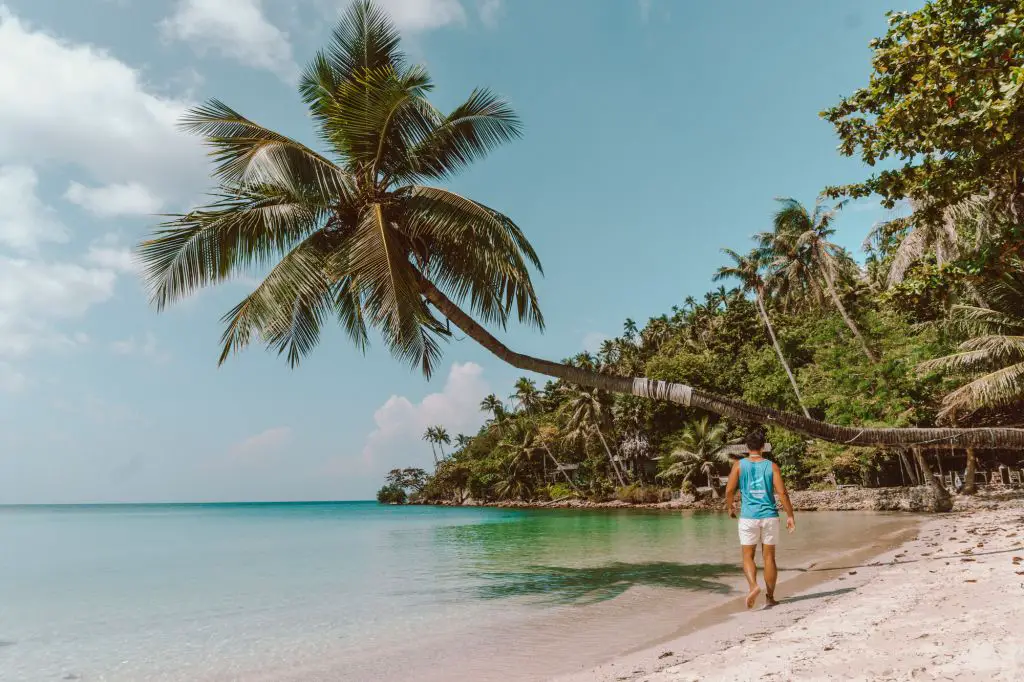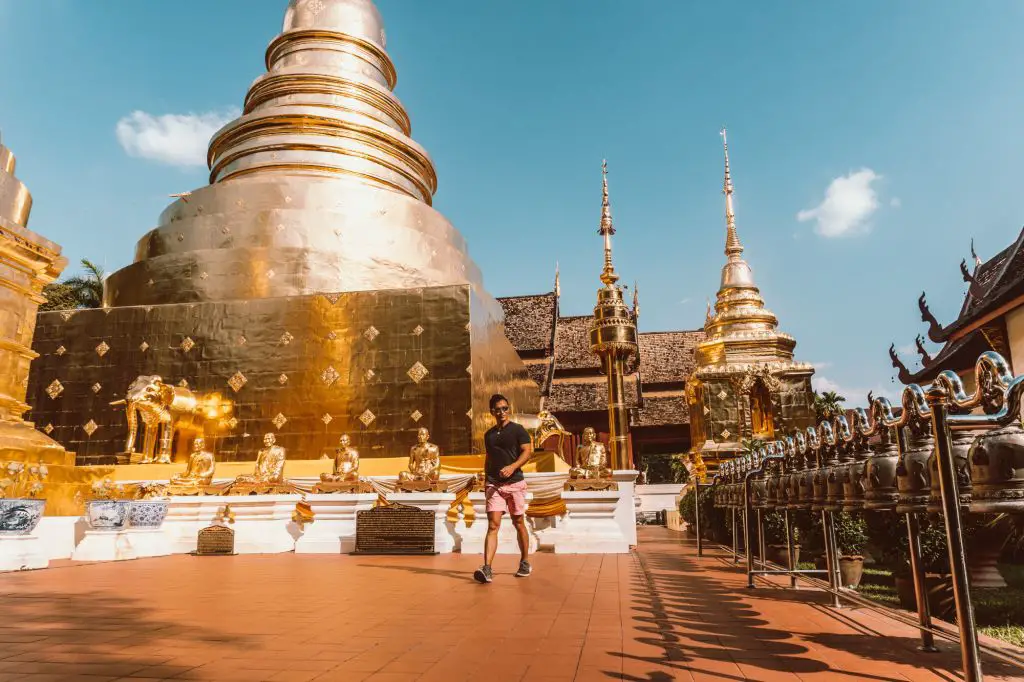Bangkok, the vibrant capital city of Thailand, is one of my favorite cities in Asia. It is home to numerous temples, also known as “wats” in Thai. These temples are not only sacred sites but also architectural marvels, rich in history and cultural significance. I spent many weeks enjoying the street food of Bangkok, rooftop bars of Bangkok, and its endless culture but I always recommend first time visitors to properly spend a day visiting its incredible temples in its historic old quarter.
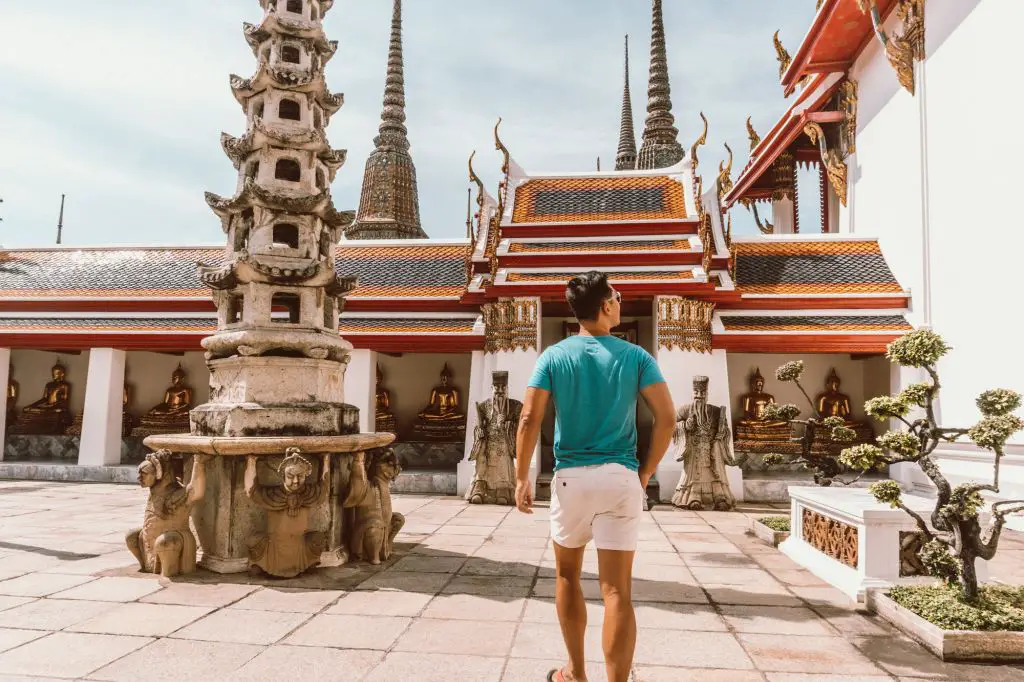
This guide will breakdown the most famous and most beautiful temples to see in Bangkok. You probably won’t see them all in a day so plan accordingly. If you only have a day, there are a few temples that are more grand and “famous” than the others so I would pick them. There are plenty more temples in Thailand to explore so don’t be sad if you miss a few in Bangkok!
A history of Bangkok and its temples
Bangkok’s history is a tapestry woven from ancient roots and the vision of its rulers. Emerging from a modest trading post in the 15th century, Bangkok took shape under the Ayutthaya Kingdom’s influence. However, Ayutthaya’s fall to the Burmese in 1767 led to a period of transition.

General Taksin rose to prominence, establishing the Thonburi Kingdom (1768–1782) with its capital in Thonburi. It was during this time that the foundation for Bangkok’s future as a majestic city was laid.
In 1782, General Chao Phraya Chakri overthrew Taksin and ascended to the throne as King Rama I, marking the beginning of the illustrious Chakri Dynasty. Recognizing the potential of the eastern bank of the Chao Phraya River, Rama I moved the capital across the river and named it Krung Thep, or “City of Angels.” This city, with its full ceremonial name, “Krung Thep Mahanakhon Amon Rattanakosin Mahinthara Yuthaya Mahadilok Phop Noppharat Ratchathani Burirom Udomratchaniwet Mahasathan Amon Piman Awatan Sathit Sakkathattiya Witsanukam Prasit,” remains the vibrant heart of Thailand.

At the heart of this new capital was the Grand Palace, a monumental complex that became the epicenter of power and culture. Within its walls, Rama I commissioned the construction of Wat Phra Kaew to house the revered Emerald Buddha, symbolizing the spiritual essence of the kingdom.
The Chakri Dynasty continued to shape Bangkok’s religious landscape. Rama II (1809–1824) oversaw the expansion of Wat Arun, giving rise to its iconic prang (spire). Rama III (1824–1851) contributed significantly to Wat Pho and Wat Traimit, enhancing their significance in Thai culture and religion.
As Bangkok evolved, it embraced modernization while preserving its heritage. Rama IV (1851–1868) saw the blending of traditional Thai architecture with Western influences. This fusion of styles added a unique character to the city’s temples.
In the 20th century, particularly under the reign of King Rama IX (Bhumibol Adulyadej, 1946–2016), efforts to preserve and restore Bangkok’s temples intensified. These sites, including the magnificent Wat Pho with its sprawling reclining Buddha and the resplendent Wat Arun with its glistening spire, became symbols of Thailand’s rich history and cultural identity.
Today, Bangkok’s temples stand as living testaments to the city’s past and present. They are not merely monuments of stone but living repositories of history, spirituality, and artistry. Visitors from around the globe are drawn to these sacred sites, each telling a story of Thailand’s journey from ancient kingdoms to the bustling metropolis it is today.
What to know before visiting temples in Bangkok
Thai temples are incredibly beautiful and a must do activity when visiting. There are a few things you should remember and take note of before embarking on your sightseeing.
Dress code for temples
Buddhist temples generally have a universal dress code of requiring one to wear pants and cover the shoulders. Women can wear dresses as long as it covers the knees.
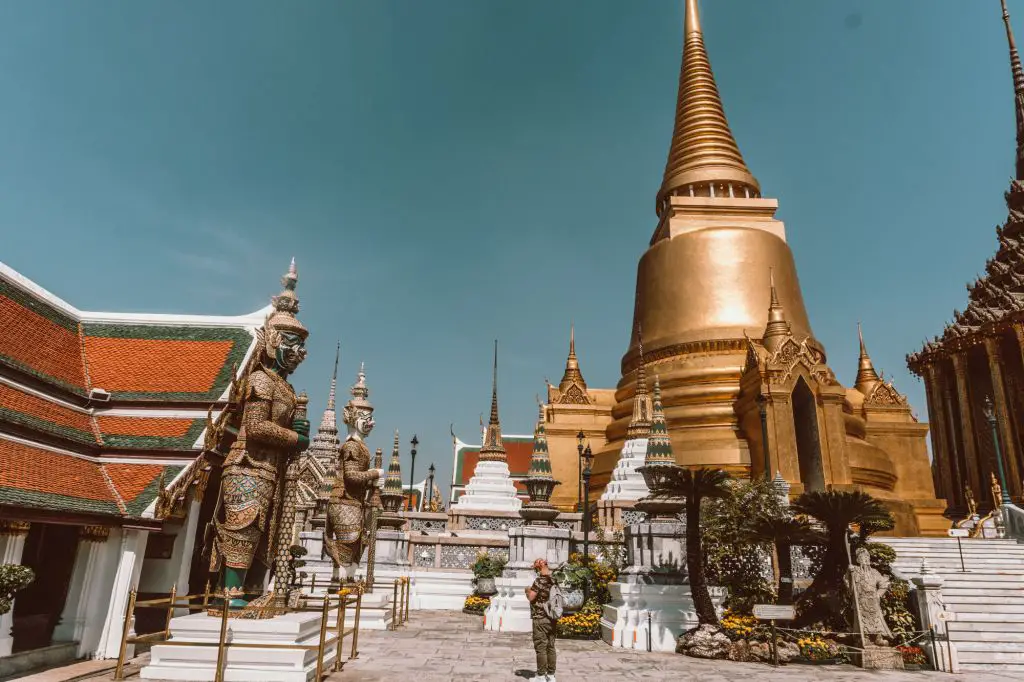
However, as Thailand has become such a tourist attraction and the weather is incredibly hot at times, I think the Government has compromised by allowing shorts to be worn by men. Tank tops are still a bit no no so make sure you have a t-shirt on you before visiting the temples in Bangkok.
Monks are regular members of the temples
Just like how beautiful churches in Europe are used for prayer services, Buddhist temples aren’t just here for you to look at. Buddhist monks are regular members of many of the temples. Many of them are praying throughout the day at even the most touristy temples. Be respectful, don’t make so much noise and try not to take too many photos.
Do not point your toes towards the buddha
When you’re inside the temples and are not Buddhist, you can still sit down and just gaze at the beauty of the Buddha statue before you. However, the one thing you should not do is point your toes at the buddha. This is considered very disrespectful and there are signs everywhere illustrating this.
You can sit on your knees or cross your legs, whatever makes you most comfortable but just do not point the toes!
Grand Palace of Bangkok
Without a doubt, the Grand Palace of Bangkok is the ultimate must visit sight in Bangkok. It’s the pride of joy of the Thai people and it’s not hard to see why. It’s been the residence of the king of Siam since the late 18th century. It’s also been the home of the Thai King, Royal Court and the administrative seat of government for more than 150 years.
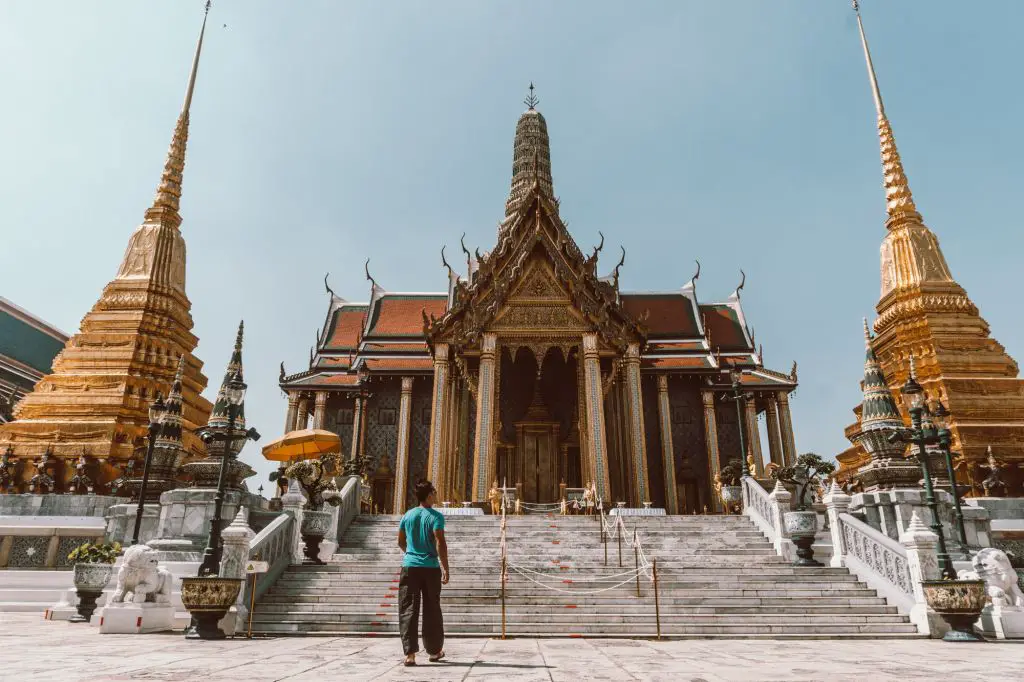
This palace lives up to its name and blows the word grand out of the water. As soon as I entered this place, my jaw dropped at the sheer amount of incredible Thai temples, statues, and other architectural feats. Everywhere you turn is just another incredible building. I particularly love the Thai architecture and you get the full on display here.
The things that stand out most to me about Thai temples are the Nagas. Nagas are mythical serpents that guarded Buddha during his meditation in the forest in northern India, and often appear on handrails at temple entrances. You’ll also see nagas decorating temple roofs, the tail at the roof peak and the body winding down to the head, rising at the roof edge.
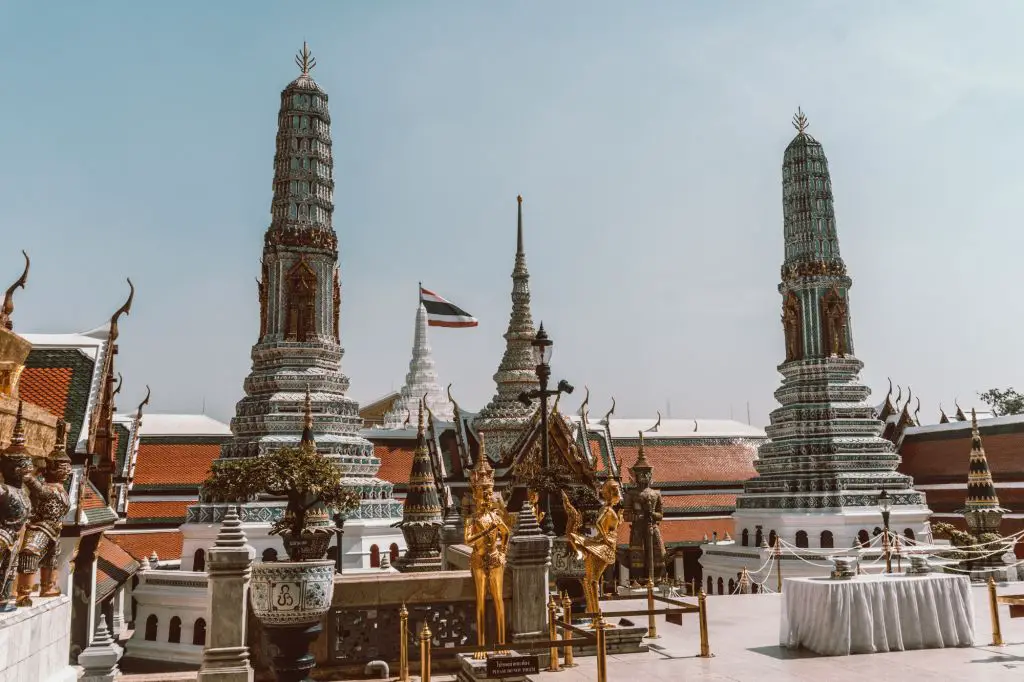
Emerald Buddha Temple
Inside the Bangkok Grand Palace is the ever famous Emerald Buddha temple. This temple houses the ultra famous Emerald Buddha. Although it is tiny in comparison to the other huge golden Buddha statues, it is important in the history of Thailand in that whomever possessed it in the past, found legitimacy for their rule. Thus kings throughout the region have desired to have the Emerald Buddha preside over and bring good favor to their capitals.
Dress code for the Bangkok Grand Palace
The dress code for entering the Grand Palace is strict and enforced. Men must wear pants and at least a t-shirt. If you are not wearing long pants, you can purchase cotton pants for 200 THB at the entrance. These pants are a bit ridiculous looking but at least you’ll be granted entrance.
For women, you’ll need to cover your shoulders and knees as well. They also sell long dresses incase you’re wearing shorts. The Grand Palace of Bangkok was the only place during my entire Thailand visit where I had to buy pants. No other temples in the country, even if they had dress code signs up, ever enforced it.
Wat Pho
Wat Pho is the largest temple complex in Bangkok. It’s incredibly stunning, although not as mind blowing as the Grand Palace. It’s located next door to the Grand Palace and across the river from the Temple of the Dawn. This area of the capital is definitely the temple hotspot with the three most famous temples within short walking distance from each other.
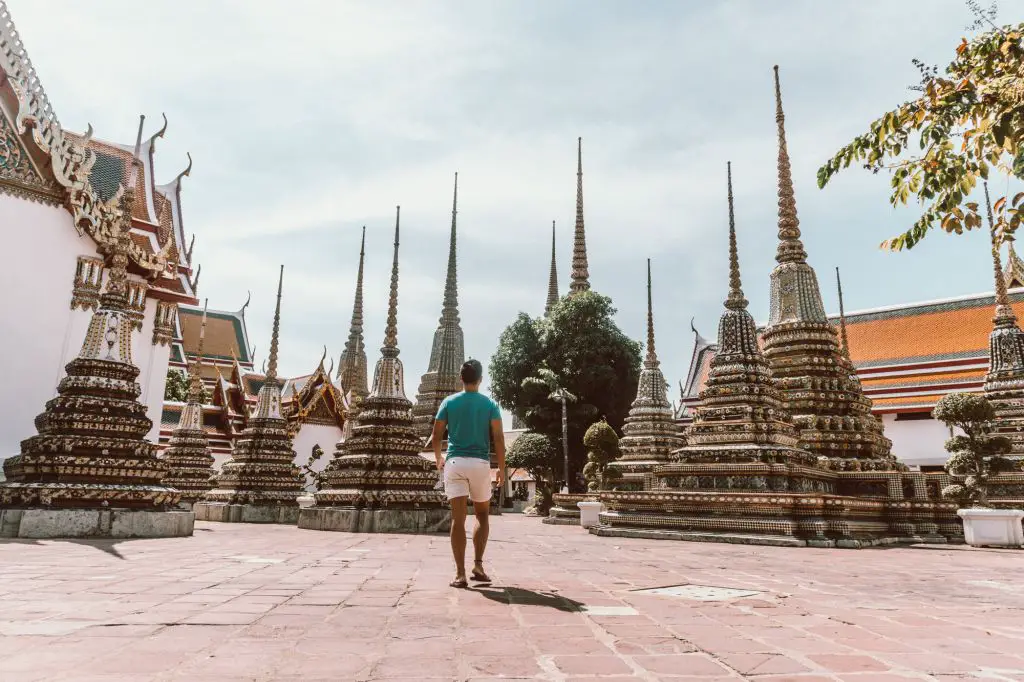
Wat Pho was built in the 16th century before Bangkok was made the capital city.
It’s well worth having a look around the entire temple compound. Wat Pho’s chapels and stupas feature thousands more Buddha images and golden statues, in addition to many Chinese sculptures. Wat Pho is also a great place to experience a traditional Thai massage. Indeed, the temple is site of one of the country’s top schools for massage therapy and other traditional Thai healing practices.

Leaning Buddha Statue
Without a doubt, the main star of Wat Pho is the temple of the leaning Buddha. This temple houses an enormous golden Buddha statue lying down on their side. The statue is ridiculous large at over 40 meters! It takes up the entire temple and one of the largest buddha statues in Thailand.
Temple of The Dawn
Wat Arun, also known as the Temple of the Dawn, is located on the west (Thonburi) bank of the Chao Phraya river. It’s probably the most picturesque temple in all of Bangkok just because of how massive it is. The central spire is a whopping 80 meters tall which makes it largest in the city.


It’s located just due west of Wat Pho and there is a passenger ferry that connects the two temples. This way you won’t need to walk across the bridge to get between the two. This ferry is 4 THB one way.
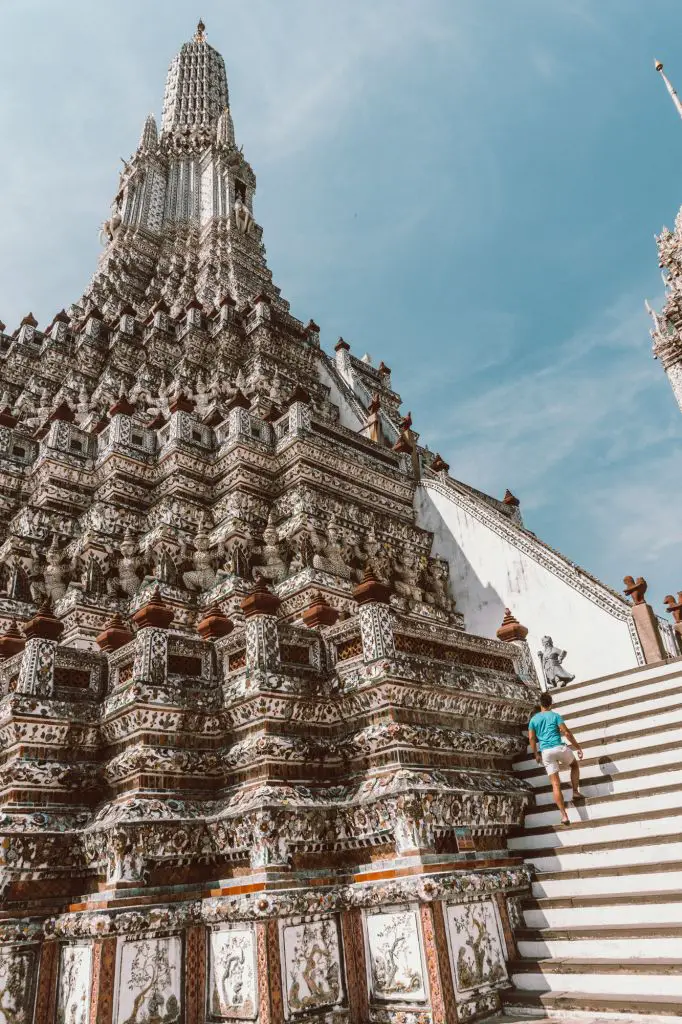
The temple is normally packed full of tourists but visiting during COVID meant that it was mostly empty. I just found the structure to be absolutely mind boggling especially with the incredible attention to detail that you find with every structure. Just the sheer amount of mini statues carved into the temple is incredible. The amount of time and manpower it must have taken to construct these structures is beyond me.
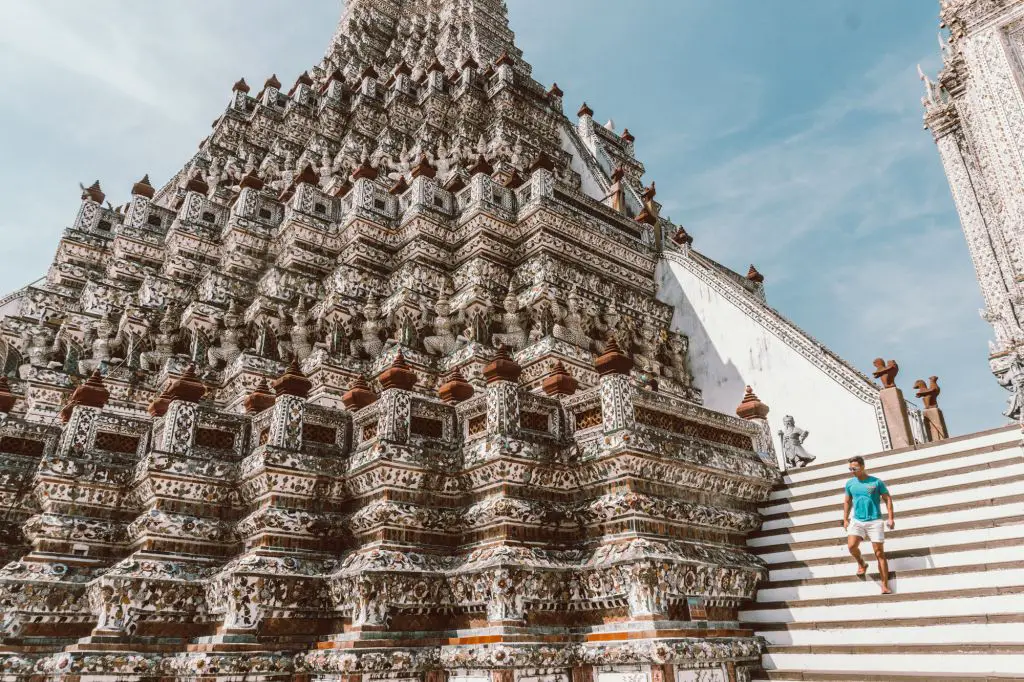
Wat Arun was envisioned by King Taksin in 1768. It’s believed that after fighting his way out of Ayutthaya, which was taken over by a Burmese army at the time, he arrived at this temple just as dawn was breaking. He later had the temple renovated and renamed it Wat Chaeng, the Temple of the Dawn.
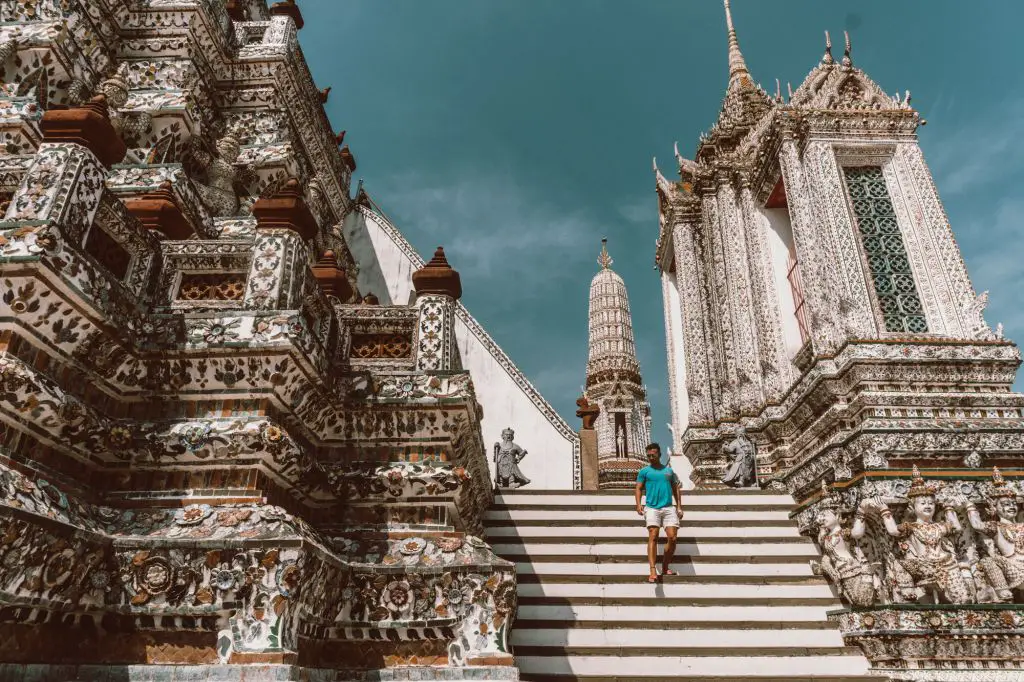
The temple is smaller than say Wat Pho so you don’t need to spend a lot of time here.
Wat Ratchanatdaram Worawihan (Loha Prasat)
Visiting Wat Ratchanatdaram in Bangkok is a journey into serenity and architectural beauty. This temple, also known as Loha Prasat or the ‘Metal Castle’, stands as a unique and striking landmark in the city. Located near the popular Khao San Road, it offers a tranquil escape from the bustling streets of Bangkok.

As you approach Wat Ratchanatdaram, you’re immediately struck by its unusual structure. The highlight of the temple is its Loha Prasat, a multi-tiered structure that resembles a castle made of metal spires. This architectural marvel is one of the few remaining structures of its kind in the world, with 37 metal spires symbolizing the 37 virtues toward enlightenment in Buddhist belief.
Upon entering the temple grounds, you’re greeted by the serene atmosphere typical of Thai temples. The courtyard is adorned with lush greenery and intricate stone sculptures, creating a peaceful oasis in the heart of the city. The main hall of the temple, while relatively simple compared to the Loha Prasat, is adorned with beautiful murals depicting scenes from the life of the Buddha.
Climbing the Loha Prasat offers a unique perspective of Bangkok’s skyline. As you ascend the steep staircases, you’re treated to panoramic views of the surrounding area, including the nearby Golden Mount and the bustling streets below. The gentle breeze and the sound of the city in the distance create a sense of calm and introspection.
Visitors to Wat Ratchanatdaram can also participate in traditional Buddhist practices, such as offering prayers and lighting incense. The temple provides a glimpse into Thailand’s rich religious and cultural heritage, making it a must-visit for anyone exploring Bangkok.
In addition to its spiritual significance, Wat Ratchanatdaram also hosts various cultural events and festivals throughout the year. These events offer a deeper understanding of Thai traditions and provide an opportunity to witness colorful ceremonies and performances.
Wat Saket (Golden Mount)
Nestled amidst the lively streets of Bangkok, a city that never seems to slow down, there exists a serene sanctuary that beckons both locals and travelers alike. Welcome to Wat Saket, affectionately known as the Golden Mount Temple, a place where the past meets the present in a harmonious blend of spirituality and history.
As you approach Wat Saket, it’s hard not to be captivated by the sight of its gleaming golden chedi, standing tall against the backdrop of the city’s skyline. This iconic structure, adorned with intricate details that catch the sunlight just right, acts as a guiding light, drawing you closer to its sacred grounds.

The journey to the top of the Golden Mount begins with a climb up a winding staircase that wraps around the hill. With each step, you’re enveloped in a sense of tranquility, surrounded by lush greenery and the distant murmur of prayer chants. It’s a moment to slow down, to take in the sights and sounds that make this temple so special.
Reaching the summit, you’re greeted with a breathtaking panorama of Bangkok sprawling below you. The modern skyscrapers stand in contrast to the traditional rooftops of nearby temples, offering a unique perspective of the city’s vibrant tapestry.
Exploring the temple grounds, you’ll discover more than just stunning architecture. Ancient statues, ornate shrines, and peaceful prayer halls invite you to pause and reflect. The history of Wat Saket, dating back to the Ayutthaya period, is palpable in every stone and statue, providing a connection to Thailand’s rich cultural heritage.
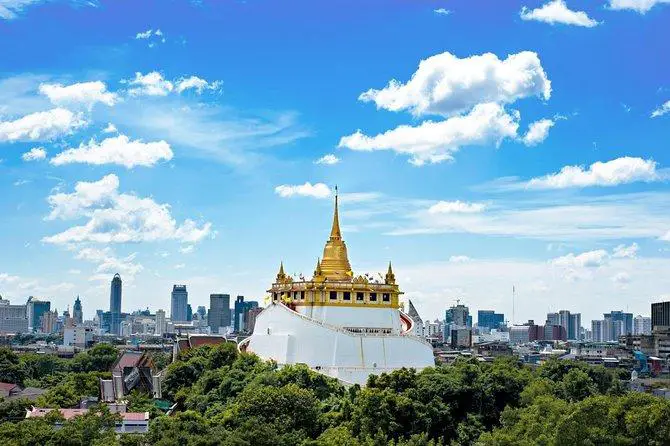
But Wat Saket is more than just a place of worship; it’s a living, breathing part of Bangkok’s history. Once used as a crematorium during times of plague, the temple earned the somber nickname “The Mountain of Ashes.” This history adds a layer of depth to the temple’s story, reminding us of the resilience of the human spirit.
Throughout the year, Wat Saket hosts various festivals and events, including the vibrant Loy Krathong festival. During these times, the temple comes alive with color and energy as devotees gather to pay their respects and release lotus-shaped floats into the air.
In essence, Wat Saket is a sanctuary for the soul, a place where tradition and modernity coexist in perfect harmony. Whether you’re seeking a moment of peace and reflection or a deeper connection to Bangkok’s history, this temple offers it all. So next time you find yourself in the bustling streets of Bangkok, take a detour to Wat Saket and discover the magic of the Golden Mount Temple.




